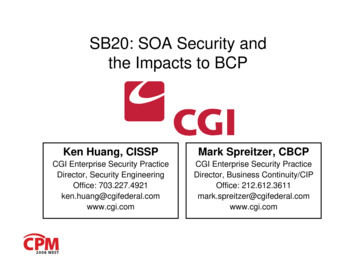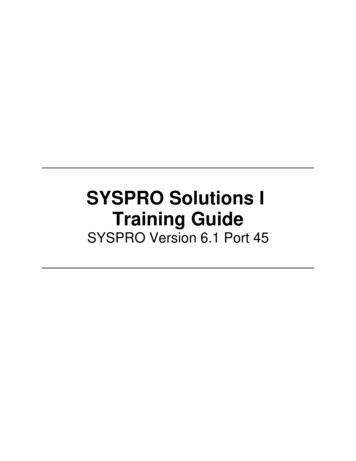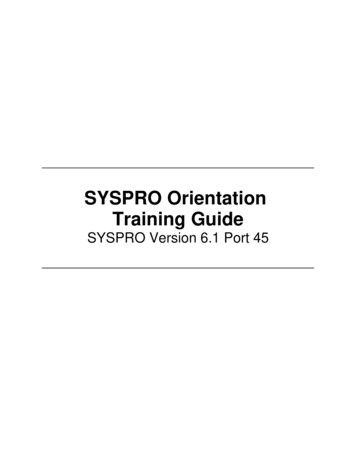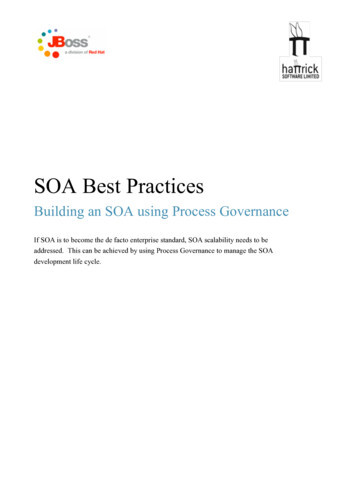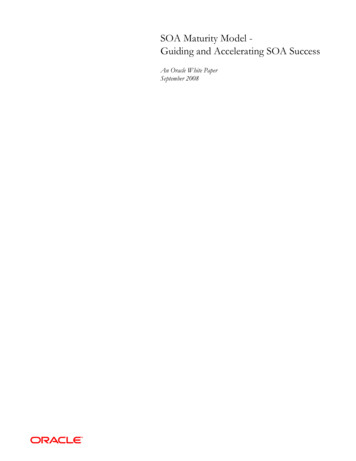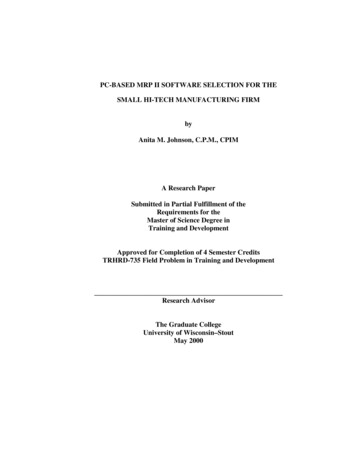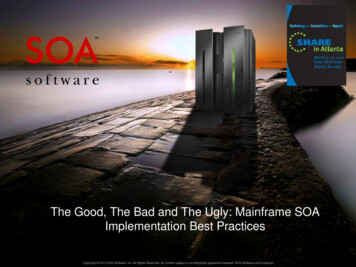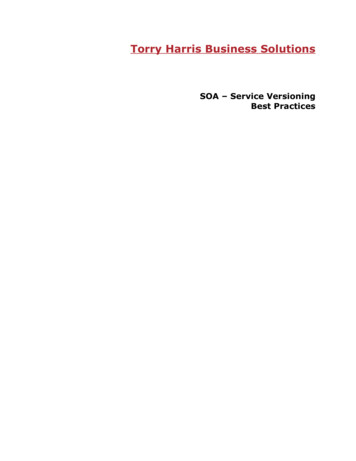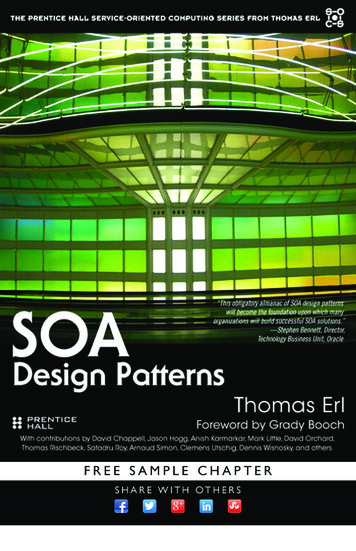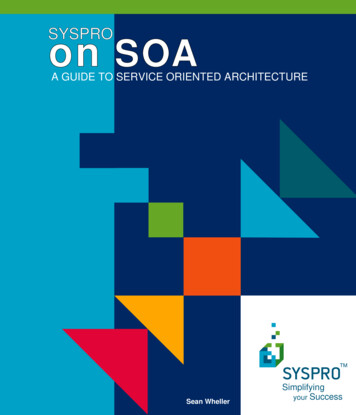
Transcription
on SOASYSPROA GUIDE TO SERVICE ORIENTED ARCHITECTURESean WhellerSimplifyingyour Success
SYSPRO on SOAA Guide to Service OrientedArchitectureSean WhellerSYSPRO (PTY) Ltd.
SYSPRO on SOA: A Guide to Service OrientedArchitectureby Sean Wheller and SYSPRO (PTY) Ltd.Published 2006This document is made available by SYSPRO Ltd. under terms of the Creative CommonsAttribution-NonCommercial-NoDerivs 2.5 ] license. Whatfollows is a human readable summary of the complete Legal Code (the full -nd/2.5/legalcode].Creative Commons DeedAttribution-NonCommercial-NoDerivs 2.5You are free: to copy, distribute, display and perform the workUnder the following conditions:Attribution. You must attribute the work in the manner specified by the author or licensor.Noncommercial. You may not use this work for commercial purposes.No Derivative Works. You may not alter, transform, or build upon this work. For any reuse or distribution, you must make clear to others the license terms of this work. Any of these conditions can be waived if you get permission from the copyright holder. Your fair use and other rights are in no way affected by the above.SYSPRO is a trademark of Syspro Ltd. All other trademarks, service marks, products or services are trademarksor registered trademarks of their respective holders. SYSPRO is produced under license by Syspro Ltd. SysproLtd. reserves the right to alter the contents of this book without prior notice. While every effort is made to ensurethat the contents of this book are correct, no liability whatsoever will be accepted for any errors or omissions. Thisbook and all materials supplied to the student are designed to familiarize the customer, reseller or student with thesubject.
Table of ContentsPreface . xiiiWho should read this book . xiiiAbout this Book .xivAcknowledgments .xvSYSPRO Enterprise Software .xviFeedback .xviI. Overview .11. Introduction .32. Background .71960s-Pre-Computer Era .71970s/1980s - Advent of Computers in Manufacturing .8MRP - The Initial Impact .8CRP - The Next Development .9MRPII - Connecting Manufacturing and Finance .103. Computing Today .131990s - Enterprise Resource Planning .13ERP Defined .14Impact of the Personal Computer .14Evolution of ERP to ERPII .15II. Extended Enterprise .174. Business Drivers .19Globalization .19Flexibility and Agility .21Real Time Information .23Pro-active Decision Making .25Conclusion .255. Connecting all the Pieces .27Business Processes .27Transactions .29Intelligence .29Collaboration .30Business Information .31Business User .32Making the Connections .336. Service Orientation .35Introduction to SOA .35SOA Defined .36
viSYSPRO on SOAQuick History of SOA .37Key Concepts in SOA .39Services .39Loose Coupling .42Interoperability .44Dynamic Discovery .45Front Ends .46Message Based Technology .47Distributed Network Architecture .48Web Services .50From Key Concepts to Supports .517. SOA Supporting Concepts and Technologies .53Poles, Pegs and Ropes .53XML .54XML Schemas .56Enterprise Software Bus .58WSDL .60SOAP .61Grid Computing .62Ethernet .66Broadband .66GSM .67RFID .68Client Front Ends .70A Whole Tent .718. Benefits of SOA .73Introduction .73The Business Value of SOA .73Agility .74Better Return on Investment .76Service Assembly .77Lower Development Costs .77Future Proofing .78Better Scalability .79Improved Business Alignment .79Improved Customer Satisfaction .80Summary .80The IT Benefits of SOA .81Code Mobility .81More Code Reuse .82Focused Developer Roles .82Better Parallelism in Development .83
viiBetter Testing/Fewer Defects .83Support for Multiple Client Types .84Better Maintainability .84More Security .85Summary .85Assembly Without Programming - The Composite ApplicationPlatform .86Dynamic Meta Data Repository .88Refining Services .88Defining Interoperability .89Conclusion .899. Challenges of SOA .91Introduction .91Technical Challenges .91Data Rationalization .92Business Service Enablement .93Abstraction Incompatibility .94Service Accessibility .94Constrained Innovation .95Standards Interoperability .95Business Challenges .96Transfer Pricing Model .96Ensuring Customers Service Levels .97Consequences of Change .97Ownership Issues .98Roadblocks Ahead .98The Build vs. Buy Argument .99Background . 100Buy (Packaged Solution) . 100Build (Custom Application) . 102Somewhere In Between . 103Conclusion . 10510. Security in SOA . 107Security Concerns . 107Trust . 108Message Security . 108Distributed Policies . 109Identity Management . 110Interoperability . 110Current Web Based Security Standards . 111SOA Security Summary . 11211. Summary of SOA . 113
viiiSYSPRO on SOAIII. SOA Models . 11512. Demand Driven Supply Networks . 117Introduction to DDSN . 117Collaborative Supply-Chain . 118Synchronized Swimming . 119Demand Management . 119Supply Excellence . 120Continuous Innovation . 120DDSN Capability Model . 12013. Collaborative Planning, Forecasting and Replenishment . 123Introduction to CPFR . 123The CPFR Model . 124Strategy and Planning . 125Demand and Supply Management . 125Execution . 126Analysis . 126IV. Implementation . 12914. Introduction . 13115. Implementation Methodologies . 133Technologies and Tools . 133Methods . 13516. Business Models . 13917. Planning . 141Examining the Impact of Change . 141Logical Migration . 142Technical Migration . 143Web Services Management Platform Requirements . 144Service Continuity - Improving and Keeping Everything Going 146Align . 147Comply . 147Observe . 148Respond . 148Optimize . 149Achieving SOA Command and Control . 149Achieving Integration . 150User Interaction Integration . 151Business Process Integration . 152Application Integration . 153Data Integration . 154Choosing the Right Integration Solution . 154Data Transformation and Rationalization . 154Architecting an Effective Solution for your Enterprise . 159
ix18. SOA Adapting to Change . 163Increased Enterprise Responsiveness to Change . 163Increased Responsiveness to Market Change . 165Enterprise SOA - Large, Dynamic and Rife with Interdependencies. 170The Impact of Change within a SOA . 170Unexpected Change to a Networked Service . 171Example of the Impact of Change . 173Planned Change to a Networked Service . 180Planned Simultaneous Change to Many Networked Services . 182The Ultimate Impact of Change Skyrocketing Costs . 184Web Services Management Platform Requirements . 188Architecting a Solution . 191Service Deployment Action . 194The Solution in Action . 199SOA Implemented . 202V. Applications . 20519. Introduction . 20720. SYSPRO e.net solutions and the Extended Enterprise . 209Product Description . 209Extending the Enterprise . 210Extending Functionality . 210Extending Boundaries . 211Custom Application Development . 211Enterprise Application Integration . 211Electronic Commerce . 212Collaborative Commerce . 212Collaborative Private Exchanges . 21221. Intra-Enterprise . 21322. Inter-Enterprise . 215VI. SYSPRO - In Action . 21723. Introduction . 21924. Dewhurst plc. . 221The Situation . 221Planning Stages . 222What a Difference! . 223SOA Summary . 22625. Lakeshirts, Inc . 227The Situation . 227Solution . 228Action Results . 228The New System . 229
xSYSPRO on SOA26. Union Carriage and Wagon . 231UCWs' Need . 231Existing Conditions . 233Planning . 234Execution . 236Results . 23927. Bendalls Engineers . 241The Company . 241The System . 242The Results . 24328. Cedarlane Laboratories Limited . 245The Company . 245SYSPRO Scalability . 245SYSPRO SOA Solution . 246SOA Results . 247Bibliography . 249
List of Figures1.1. Evolutionary Stages toward SOA .45.1. Connecting People, Processes and Information .286.1. CD Player as a Service .366.2. Charge Credit Card Service (Verify Customer Credit History) .406.3. Artificial dependency - different power plugs and sockets .426.4. Loose coupling advance in Christmas Lights .436.5. Message based technology .476.6. Message package .476.7. Connections within a Distributed Network Architecture .497.1. An ESB translating messages .607.2. Different parts of a process within a Grid .648.1. Combining individual services into a composite application .8713.1. Framework of the CPFR Model . 12413.2. Strategy and Planning Tasks . 12513.3. Demand and Supply Management . 12613.4. Execution . 12613.5. Analysis . 12716.1. The Enterprise Framework . 14017.1. The 5 View Model . 16017.2. Practice of SOA . 16118.1. From monolithic to loosely-coupled, simpler, modular softwarecomponents . 16418.2. Initial project built with Web Services: Clearing excess inventory . 16618.3. Customers are quickly provided direct ordering access through ecommerce . 16718.4. Web Services leveraged across the enterprise to power real-time businessactivity monitoring . 16818.5. New services and applications continue to be built, enhanced andconnected . 16918.6. First Impact . 17318.7. Second Impact . 17418.8. Third Impact . 17518.9. Fourth Impact . 17618.10. Fifth Impact . 17718.11. Sixth Impact . 17818.12. Failures appear to be random and unrelated . 17918.13. Sources of change in an enterprise service network . 18518.14. Running and evolving an unmanaged enterprise service network . 186
xiiSYSPRO on SOA18.15. Skyrocketing costs and complexity of an unmanaged service network 18718.16. Service brokers, Web Service providers and a centrally managed policy. 19118.17. Alternate deployment option placing Active Agent on Web Serviceprovider . 19218.18. Service brokers and active agents deployed in support of initial project. 19518.19. New application components link to existing services . 19618.20. Successive project deployments . 19718.21. The effective Web Services Management Platform . 19818.22. Service broker intermediates provider and consumer interactions . 19918.23. Non-disruptive application or service replacement . 20018.24. Web Services management platform automates reactions . 20118.25. Web Services Management Platform lowers the cost curve . 20226.1. UCW Project Timeline . 237
PrefaceWelcome to SYSPRO on SOA. This book is a guide to what is probably one of themost profound and exciting changes in the history of information technology;Service Oriented Architecture (SOA).The subject of SOA is as endless as there are technologies to implement. For everyexpert on the subject you will find a slightly different perspective thereon and twentyothers who disagree in whole or in part. Perhaps the reason for this is the abstractnature of Service Oriented Architecture. Perhaps the reason is that there can be asmany permutations of what a Service Oriented Architecture should be, could be,would be, as there are companies whose IT systems must evolve to expose SOAcapabilities.Despite expert differences, software as a service is beginning to take hold.Who should read this bookWhile industry experts will surely find much educational value in this book, theprimary audience in mind while writing this book is non-expert.SYSPRO on SOA aims to explain SOA in the simplest terms possible. Rather thanexplain SOA from an IT perspective, which most books on the subject do, theSYSPRO on SOA approach is from a business perspective. It is this focus onbusiness process that makes SYSPRO on SOA unique amongst other books on thesubject.If you are a business manager or business process engineer, SYSPRO on SOA willhelp you understand the concepts of SOA and the benefits thereof from the businessperspective.While SYSPRO on SOA is a book written by SYSPRO, the platform and technologyneutral, heterogeneous nature of SOA means that most of the knowledge gainedfrom this book will remain applicable in most business computing environments.As one of less than a handful of books on the subject, SYSPRO on SOA is avaluable addition to the library of any person having to evolve IT-capabilities andalign them with the future.
xivPrefaceAbout this BookThis book is divided into six parts, corresponding to particular topic groups. Theinformation in each part is intended to be read in order, each part and chapterbuilding on the one before it. It is also possible to use this book in a non sequentialorder, as a reference.At the start of each part an abstract is provided to give you an idea of the informationcontained within the part. If you find that you are already familiar with a topic, youcan skip ahead to the next heading. When skipping sections, keep in mind thatknowledge of specific concepts relayed in previous sections may be assumed. Part I, “Overview” [1] - traces the relationship between business and IT so youwill better understand the development of business software from materialsrequirement planning (MRP) to full blown extended enterprise resource planning(ERPII) systems and the move toward Service Oriented Architectures within theenterprise software framework. Part II, “Extended Enterprise” [17] - is devoted to a discussion of the businessdrivers that are currently affecting business needs and IT solutions that areencouraging companies and enterprises to examine the concept of SOA toexplore what will benefit them by adopting it. Part III, “SOA Models” [115] - presents two model applications of the SOAconcept: Demand Driven Supply Networks and Collaborative PlanningForecasting and Replenishment. These are discussed with definitions, examplesand detailed business implications. Part IV, “Implementation” [129] - discusses the process of evaluating and creatingService Oriented Architectures and provides steps and models that can befollowed along the way. Part V, “Applications” [205] - explains some systems of implementation andmanagement we now look briefly at SYSPRO applications in relation to SOA.You will find a product description, as well as discussion on the extendedenterprise, intra-enterprise relationships and inter-enterprise relationships. Part VI, “SYSPRO - In Action” [217] - contains five real life installations ofSYSPRO are presented to demonstrate SYSPRO's system as the core of aService Oriented Architecture in these different enterprises.
xvAcknowledgmentsWriting a book is always a collaborative exercise in crafting words and moldingcollective ideas into pages. This said, InWords [http://www.inwords.co.za] wouldlike to acknowledge the people who have helped in development and production ofSYSPRO on SOA.Much thanks goes to Graham Goode, member of the InWords team, who has done aincredible job of assisting me in producing this manuscript. Graham has beeninstrumental, constantly chipping away and sorting through a plethora ofinformation, rewriting what was verbose and not clear and constantly remainingopen to new ideas and the addition of perspective. Thanks Graham, working withyou has been great, really a fire and forget experience.This is t
Service Oriented Architecture (SOA). The subject of SOA is as endless as there are technologies to implement. For every expert on the subject you will find a slightly different perspective thereon and twenty others who disagree in whole or in part. Perhaps the reason for this is the abstract
